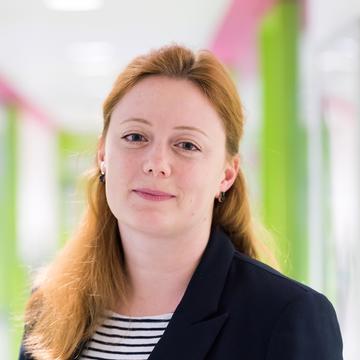Anna Regoutz

Professor Anna Regoutz
Associate Professor of Experimental Inorganic Chemistry
Our research vision is to explore the structure-electronic structure relationship in inorganic solids and how this manifests in their overall physico-chemical characteristics to integrate them into opto-electronic devices. We are an interdisciplinary team of experimentalists with key expertise in thin film synthesis, surface and interface chemistry, and X-ray photoelectron spectroscopy.
In general terms, the research program covers four key areas:
Hard X-ray Photoelectron Spectroscopy (HAXPES)
HAXPES is one of the most powerful techniques for studying the local chemical states and electronic structure of extended materials and heterostructures, e.g., those central to electronic devices. The high X-ray energies used in this technique enable larger depth information, making it possible to study buried layers and interfaces. We work on developing and applying the technique across a broad spectrum of materials, including new measurement strategies and in-situ and in-operando approaches for the often complex structures found in devices at synchrotrons and in the laboratory. Within the context of X-ray-based characterisation techniques, we also have a core interest in establishing a fundamental understanding of X-ray irradiation effects on inorganic samples and what we can learn about the material itself based on the radiation effects observed.
Sol-gel methods for thin films
Sol-gel can offer low-cost, scalable pathways towards high-quality, ultra-thin films of metal oxides. We focus on developing methods for a range of oxides, concentrating on tuning their electronic structure through strain engineering and incorporation of dopants and using polymer substrates for flexible electronics. We target both their application in opto-electronic devices and use the achieved high-quality samples to explore interesting physico-chemical aspects of the materials.
Materials and interfaces in power electronics
Wide and ultra-wide band gap materials are the key to enabling devices to operate at higher voltages, frequencies, and temperatures to enable the application of power electronics in areas such as electric vehicles, photovoltaics, and power supplies. We work on both potential future materials (e.g. gallium oxide) and current industry devices based on silicon carbide. Beyond investigating bulk properties of different crystal polymorphs and thin film orientations, we mainly study interfaces in power electronic devices using hard X-ray photoelectron spectroscopy.
Inorganic materials for biosensors
Moving from enzymatic to non-enzymatic biosensors requires an in-depth knowledge of the chemistry and electronic structure of the used inorganic nanomaterials. We work on developing and optimising synthesis routes for oxide nanostructures and improve our understanding of how synthesis choices influence the materials’ physico-chemical properties and, ultimately, their sensing performance.
Associated research themes
Anna Regoutz is an Associate Professor of Experimental Inorganic Chemistry and Tutorial Fellow at St Edmund Hall. Anna leads an interdisciplinary and diverse experimental research group in the Inorganic Chemistry Laboratory.
Anna received her BSc (2009) and Dipl. Ing. (2010) from the Graz University of Technology, Austria. She conducted her D.Phil. research in Inorganic Chemistry between 2010 and 2014 under the supervision of Prof. Russell Egdell at the University of Oxford and Trinity College. During this time, she was awarded a graduate scholarship by Trinity College and served as the President of the Middle Common Room at Trinity College from 2011-2013.
Subsequently, she undertook postdoctoral work at the University of Southampton and Imperial College before taking up an Imperial College Research Fellowship between 2017 and 2019 in the Department of Materials at Imperial College London. She was also a CAMS-UK Fellow from 2019 to 2023. From 2019 to 2024, she held a Lectureship in Materials Chemistry in the Department of Chemistry at University College London.
Anna was the 2020 recipient of the Royal Society of Chemistry’s Joseph Black Award and, in 2019, the IUPAC awarded her the element Praseodymium in the Periodic Table of Chemists.




